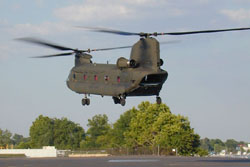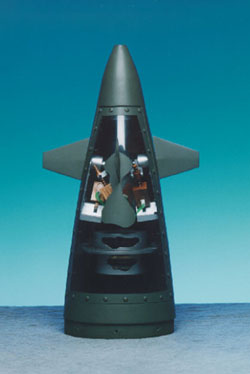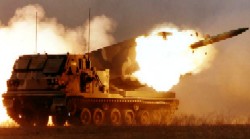Daily News
by Gail Helmer
[ Send Us News | Archives ]
Sontage Interactive today announced a publishing agreement with Macmillan USA for its Game Commander 2 voice control product. Macmillan will supply retail stores with Sontage's Game Commander 2 retail package, which contains the Game Commander 2 software and a noise-canceling head-worn microphone. Beginning now, Game Commander 2 can be found at major retail chains such as Fry's Electronics, J & R Music World, CompUSA and Amazon.com. The Game Commander 2 retail package will be available for an MSRP of $39.95.
Game Commander 2 offers exceptional voice command recognition with even faster command response than its predecessors (Game Commander and Game Commander MX). It also provides enhanced control of games with global commands, multi-channel auto fire, customizable audible feedback and a powerful command editor.
Shrapnel Games Mega Contest Underway
Shrapnel Games announced today the start of their $1,000 grand prize contest. The contest, which runs through August 30, 2001, is intended to celebrate the 2nd Anniversary of Shrapnel Games and to show off their new website. The contest is based on the Shrapnel Games' mascot, Sarge, who is being held Prisoner Of the Web (P.O.W. get it?) by the evil Company President, Tim Brooks. You must find Click here for further details.
Conflict: Desert Storm Screens
London-based SCi Entertainment Group has released a new group of screenshots from its upcoming tactical-action game Conflict: Desert Storm. The new screens show off some of the characters and environments that will be featured in the game, which is based on the 1991 Persian Gulf War.



Players will control a group of four Special Forces soldiers in a series of missions. Each soldier will have a different specialty, such as infiltration, demolitions, heavy weapons, and sniping, and players can control each soldier individually or control them all as a group. The game will also feature a variety of vehicles, including helicopters, tanks, and jets. Release Date: 2002
The U.S. Marine Corps today got its first pilot evaluation of the Lockheed Martin Joint Strike Fighter's vertical takeoff, hover and vertical landing performance. Maj. Art "Turbo" Tomassetti became the first Marine and only the second pilot to fly the short-takeoff/vertical landing (STOVL) X-35B, which is demonstrating JSF requirements for the Marines and the United Kingdom Royal Air Force/Royal Navy. With today's flight, Tomassetti also becomes the first pilot to have flown all three X-35 variants: the X-35A, X-35B and X-35C.

"On a hot day in the high desert, the X-35B demonstrated the kind of vertical performance that Harrier pilots dream about," said Tomassetti, a Harrier pilot who also serves as X-35 test pilot for the Marine Corps. "With my three press-ups today I am convinced that we are on the right track. "No matter how many times you do it, hovering a jet airplane always feels a little magical, and today was no exception. My compliments to the entire team for putting together a very nice hovering machine."
Tom Burbage, executive vice president and general manager of the Lockheed Martin JSF program, characterized Tomassetti's flight as a milestone. "Getting a U.S. Marine in the X-35B's cockpit represents a critical step forward in our flight test program, because this is the airplane Marine pilots will rely upon in the future," Burbage said. "As we saw today, the X-35B continues to demonstrate phenomenal lifting power in unfavorable conditions: 2,500-foot high-desert elevation with temperatures above 80 degrees Fahrenheit. And the airplane is incredibly stable."
A Royal Air Force pilot is scheduled to fly the aircraft over the weekend.
Boeing Completes First CH-47F Chinook Flight
Boeing has launched another chapter in the history of its longest-running continuous aircraft production program. The new CH-47F Chinook prototype heavy-lift helicopter, the sixth Chinook type designed for the U.S. Army, recently completed its first flight at the Boeing Philadelphia manufacturing facility.

The June 25 flight, which involved hover and basic maneuvers, capped a series of comprehensive system checks leading to takeoff precisely as scheduled in the CH-47F program agreement completed three years ago.
"The first flight was flawless," said Roger A. Krone, vice president and general manager, Boeing Army Programs/Rotorcraft. "Our Chinook Team demonstrated not only technical excellence, but also a total commitment to our U.S. Army customer. The entire first-flight crew-pilots, engineers, technicians and support personnel-accomplished our program-schedule goals with consistently good performance and solid teamwork. They set a high standard for all our production programs."
A Boeing Philadelphia flight crew consisting of Erik Kocher, Chinook program chief test pilot; Randy Wells, test pilot; Joe Schluck, flight test engineer; and John Rose, crew chief, lifted off shortly before 7 p.m., EDT, and remained airborne for about five minutes to validate aircraft handling qualities.
"It was wonderful," Kocher said. "The aircraft performed right up to expectations while we completed rotor blade track and balance and crosswind hover as scheduled. The aircraft controlled nicely, and all systems functioned as advertised."
The CH-47F modernization program will sustain the U.S. Army's Chinook fleet to provide rotary-wing heavy-lift capabilities well into the 21st century. Modernization will include aircraft remanufacturing, vibration reduction, improved avionics with integrated digital mission management systems and a digital map, and installation of more powerful Honeywell T55-GA-14A-714 engines. These core elements of the program will reduce operational and support costs to below those of the original CH-47D and provide at least another 20 years of economical and effective service. That means Chinooks will wind up serving in the Army's inventory for more than 70 years, an unprecedented record of service for military aircraft.
Funding Keeps Ticking For F-22
Lockheed Martin has been awarded two contracts by the US Air Force to keep the F-22 Raptor programme ticking along until Secretary of Defense Rumsfeld makes a decision on the future of the aircraft.

The first $320 million contract is to provide for three months (July-September) advance procurement in support of low rate initial production of 10 F-22 aircraft and associated equipment (Lot I).
The second contract, for $120.5 million is for advance procurement supporting low rate initial production of 13 F-22 aircraft and associated equipment (Lot II).
The future of the F-22 is included in the 'root and branch' review of defence requirements ordered by the Bush Administration which is coming to fruition over the next few months.
MLRS Rocket Successful in Second Ballistic Test
The U.S. Army and Lockheed Martin Missiles and Fire Control successfully tested the new Guided version of the Multiple Launch Rocket System (MLRS) rocket at White Sands Missile Range, N.M. Conducted on June 27, this was the second successful ballistic flight test of the Guided MLRS rocket.

The missile was launched from an MLRS M270 launcher. Major test objectives included the successful launch of the missile from the canister, nominal motor performance, tail fin deployment and rotation, and telemetry performance. Preliminary data indicate all test objectives were successfully achieved.
"We are continuing to prove out the Guided MLRS rocket's systems," said Ron Abbott, vice president - Fire Support for Missiles and Fire Control. "We evaluated several facets of the rocket performance during this test, such as determining the spin rate of the tail fin assembly as the rocket exited the tube, and a few items relating to launch and motor performance. The Guided MLRS rocket has met or exceeded all of our expectations during these first two flight tests, putting the program in an excellent position for the first guided flight this fall."
The Guided MLRS rocket program is an international cooperative program between the U.S., U.K., Italy, France and Germany.
The Guided MLRS rocket incorporates global positioning system (GPS)-aided inertial guidance package integrated on a product-improved rocket body. Additionally, small canards on the Guided rocket nose will provide basic maneuverability and enhance the accuracy of the system. Guided MLRS initial operational capability is scheduled for FY'04.
Guided MLRS is the next major step in the evolution of the MLRS Family of Munitions, offering advanced capabilities, reduced logistics support and precision attack. The rocket will have a range of approximately 60 kilometers.
Exponent Signs Land Warrior Contract
Exponent, Inc. announced today that it has signed a follow-on contract with the United States Army to be program manager for the development of the Army's Land Warrior system. Land Warrior is an integrated digital system that incorporates computerized communication, navigation, targeting, and protection systems for use by the dismounted infantry soldier on the battlefield of twenty-first century.
As program manager and system engineer, Exponent is leading the six-member consortium through development, testing, and assembly of the pre-production Land Warrior units. The contract extends through July 2003 and will be funded incrementally. The first phase will apply to the current government fiscal year, ending September 30, 2001. For this period, Exponent will receive $3.8 million, from which the company expects to realize approximately $1.5 million in net revenues. The pricing of subsequent phases will be determined in the future. Exponent estimates that its portion of the consortium contract will be approximately $20 million, from which Exponent expects to realize approximately $9 million in net revenues.
"We are pleased to have this contract in place, allowing us to continue to lead this exciting technology development program," said Michael R. Gaulke, President and CEO. "The success of the Land Warrior system to date has raised the interest of other military programs in using commercial off-the-shelf technologies in their applications. We continue to be encouraged by this interest and the opportunity to assist other clients using the Land Warrior development paradigm."
Final MLRS M270A1 Developmental Flight Test
Today, Lockheed Martin Missiles and Fire Control - Dallas successfully conducted the final developmental flight test of the Multiple Launch Rocket System (MLRS) upgraded M270A1 launcher at White Sands Missile Range, N.M. A total of 12 MLRS Reduced-Range Practice Rockets (RRPRs) were fired successfully from the M270A1 to four different aimpoints. Operational testing of the M270A1 is scheduled to begin at Fort Sill, Okla., in August.

"We look forward to getting the MLRS M270A1 system into the hands of the user, the U.S. Army soldier. The improvements made to this weapon system, will enable the warfighter to do his/her job faster and with greater precision," said Ron Abbott, Lockheed Martin Missiles and Fire Control vice president of fire support programs.
The M270A1 program is a major upgrade to the MLRS launcher. It includes an Improved Fire Control System (IFCS) that features a Global Positioning System (GPS), as well as the ability to process large blocks of data from new smart munitions within tactical timelines. Operating and maintenance costs will be reduced because of greater reliability and ease of repair on IFCS parts.
The system also incorporates the Improved Launcher Mechanical System (ILMS) upgrade, which dramatically reduces the time needed to aim and reload the launcher. In a typical fire mission, the ILMS-equipped launcher is six times faster than the current M270 launcher. Reload time is decreased by more than 30 percent. Crew and launcher survivability will be greatly enhanced because total exposure time on the battlefield will be significantly reduced.
[ Send Us News | Archives ]
by Gail Helmer
Monday, July 2, 2001
- Game Commander 2 Hits Retail Shelves
- Shrapnel Games Mega Contest Underway
- Conflict: Desert Storm Screens
- First Marine Corps Pilot Hovers in JSF X-35B
- Boeing Completes First CH-47F Chinook Flight
- Funding Keeps Ticking For F-22
- MLRS Rocket Successful in Second Ballistic Test
- Exponent Signs Land Warrior Contract
- Final MLRS M270A1 Developmental Flight Test
PC News
Game Commander 2 Hits Retail ShelvesSontage Interactive today announced a publishing agreement with Macmillan USA for its Game Commander 2 voice control product. Macmillan will supply retail stores with Sontage's Game Commander 2 retail package, which contains the Game Commander 2 software and a noise-canceling head-worn microphone. Beginning now, Game Commander 2 can be found at major retail chains such as Fry's Electronics, J & R Music World, CompUSA and Amazon.com. The Game Commander 2 retail package will be available for an MSRP of $39.95.
Game Commander 2 offers exceptional voice command recognition with even faster command response than its predecessors (Game Commander and Game Commander MX). It also provides enhanced control of games with global commands, multi-channel auto fire, customizable audible feedback and a powerful command editor.
Shrapnel Games Mega Contest Underway
Shrapnel Games announced today the start of their $1,000 grand prize contest. The contest, which runs through August 30, 2001, is intended to celebrate the 2nd Anniversary of Shrapnel Games and to show off their new website. The contest is based on the Shrapnel Games' mascot, Sarge, who is being held Prisoner Of the Web (P.O.W. get it?) by the evil Company President, Tim Brooks. You must find Click here for further details.
Conflict: Desert Storm Screens
London-based SCi Entertainment Group has released a new group of screenshots from its upcoming tactical-action game Conflict: Desert Storm. The new screens show off some of the characters and environments that will be featured in the game, which is based on the 1991 Persian Gulf War.



Players will control a group of four Special Forces soldiers in a series of missions. Each soldier will have a different specialty, such as infiltration, demolitions, heavy weapons, and sniping, and players can control each soldier individually or control them all as a group. The game will also feature a variety of vehicles, including helicopters, tanks, and jets. Release Date: 2002
Military News
First Marine Corps Pilot Hovers in JSF X-35BThe U.S. Marine Corps today got its first pilot evaluation of the Lockheed Martin Joint Strike Fighter's vertical takeoff, hover and vertical landing performance. Maj. Art "Turbo" Tomassetti became the first Marine and only the second pilot to fly the short-takeoff/vertical landing (STOVL) X-35B, which is demonstrating JSF requirements for the Marines and the United Kingdom Royal Air Force/Royal Navy. With today's flight, Tomassetti also becomes the first pilot to have flown all three X-35 variants: the X-35A, X-35B and X-35C.

"On a hot day in the high desert, the X-35B demonstrated the kind of vertical performance that Harrier pilots dream about," said Tomassetti, a Harrier pilot who also serves as X-35 test pilot for the Marine Corps. "With my three press-ups today I am convinced that we are on the right track. "No matter how many times you do it, hovering a jet airplane always feels a little magical, and today was no exception. My compliments to the entire team for putting together a very nice hovering machine."
Tom Burbage, executive vice president and general manager of the Lockheed Martin JSF program, characterized Tomassetti's flight as a milestone. "Getting a U.S. Marine in the X-35B's cockpit represents a critical step forward in our flight test program, because this is the airplane Marine pilots will rely upon in the future," Burbage said. "As we saw today, the X-35B continues to demonstrate phenomenal lifting power in unfavorable conditions: 2,500-foot high-desert elevation with temperatures above 80 degrees Fahrenheit. And the airplane is incredibly stable."
A Royal Air Force pilot is scheduled to fly the aircraft over the weekend.
Boeing Completes First CH-47F Chinook Flight
Boeing has launched another chapter in the history of its longest-running continuous aircraft production program. The new CH-47F Chinook prototype heavy-lift helicopter, the sixth Chinook type designed for the U.S. Army, recently completed its first flight at the Boeing Philadelphia manufacturing facility.

The June 25 flight, which involved hover and basic maneuvers, capped a series of comprehensive system checks leading to takeoff precisely as scheduled in the CH-47F program agreement completed three years ago.
"The first flight was flawless," said Roger A. Krone, vice president and general manager, Boeing Army Programs/Rotorcraft. "Our Chinook Team demonstrated not only technical excellence, but also a total commitment to our U.S. Army customer. The entire first-flight crew-pilots, engineers, technicians and support personnel-accomplished our program-schedule goals with consistently good performance and solid teamwork. They set a high standard for all our production programs."
A Boeing Philadelphia flight crew consisting of Erik Kocher, Chinook program chief test pilot; Randy Wells, test pilot; Joe Schluck, flight test engineer; and John Rose, crew chief, lifted off shortly before 7 p.m., EDT, and remained airborne for about five minutes to validate aircraft handling qualities.
"It was wonderful," Kocher said. "The aircraft performed right up to expectations while we completed rotor blade track and balance and crosswind hover as scheduled. The aircraft controlled nicely, and all systems functioned as advertised."
The CH-47F modernization program will sustain the U.S. Army's Chinook fleet to provide rotary-wing heavy-lift capabilities well into the 21st century. Modernization will include aircraft remanufacturing, vibration reduction, improved avionics with integrated digital mission management systems and a digital map, and installation of more powerful Honeywell T55-GA-14A-714 engines. These core elements of the program will reduce operational and support costs to below those of the original CH-47D and provide at least another 20 years of economical and effective service. That means Chinooks will wind up serving in the Army's inventory for more than 70 years, an unprecedented record of service for military aircraft.
Funding Keeps Ticking For F-22
Lockheed Martin has been awarded two contracts by the US Air Force to keep the F-22 Raptor programme ticking along until Secretary of Defense Rumsfeld makes a decision on the future of the aircraft.

The first $320 million contract is to provide for three months (July-September) advance procurement in support of low rate initial production of 10 F-22 aircraft and associated equipment (Lot I).
The second contract, for $120.5 million is for advance procurement supporting low rate initial production of 13 F-22 aircraft and associated equipment (Lot II).
The future of the F-22 is included in the 'root and branch' review of defence requirements ordered by the Bush Administration which is coming to fruition over the next few months.
MLRS Rocket Successful in Second Ballistic Test
The U.S. Army and Lockheed Martin Missiles and Fire Control successfully tested the new Guided version of the Multiple Launch Rocket System (MLRS) rocket at White Sands Missile Range, N.M. Conducted on June 27, this was the second successful ballistic flight test of the Guided MLRS rocket.

The missile was launched from an MLRS M270 launcher. Major test objectives included the successful launch of the missile from the canister, nominal motor performance, tail fin deployment and rotation, and telemetry performance. Preliminary data indicate all test objectives were successfully achieved.
"We are continuing to prove out the Guided MLRS rocket's systems," said Ron Abbott, vice president - Fire Support for Missiles and Fire Control. "We evaluated several facets of the rocket performance during this test, such as determining the spin rate of the tail fin assembly as the rocket exited the tube, and a few items relating to launch and motor performance. The Guided MLRS rocket has met or exceeded all of our expectations during these first two flight tests, putting the program in an excellent position for the first guided flight this fall."
The Guided MLRS rocket program is an international cooperative program between the U.S., U.K., Italy, France and Germany.
The Guided MLRS rocket incorporates global positioning system (GPS)-aided inertial guidance package integrated on a product-improved rocket body. Additionally, small canards on the Guided rocket nose will provide basic maneuverability and enhance the accuracy of the system. Guided MLRS initial operational capability is scheduled for FY'04.
Guided MLRS is the next major step in the evolution of the MLRS Family of Munitions, offering advanced capabilities, reduced logistics support and precision attack. The rocket will have a range of approximately 60 kilometers.
Exponent Signs Land Warrior Contract
Exponent, Inc. announced today that it has signed a follow-on contract with the United States Army to be program manager for the development of the Army's Land Warrior system. Land Warrior is an integrated digital system that incorporates computerized communication, navigation, targeting, and protection systems for use by the dismounted infantry soldier on the battlefield of twenty-first century.
As program manager and system engineer, Exponent is leading the six-member consortium through development, testing, and assembly of the pre-production Land Warrior units. The contract extends through July 2003 and will be funded incrementally. The first phase will apply to the current government fiscal year, ending September 30, 2001. For this period, Exponent will receive $3.8 million, from which the company expects to realize approximately $1.5 million in net revenues. The pricing of subsequent phases will be determined in the future. Exponent estimates that its portion of the consortium contract will be approximately $20 million, from which Exponent expects to realize approximately $9 million in net revenues.
"We are pleased to have this contract in place, allowing us to continue to lead this exciting technology development program," said Michael R. Gaulke, President and CEO. "The success of the Land Warrior system to date has raised the interest of other military programs in using commercial off-the-shelf technologies in their applications. We continue to be encouraged by this interest and the opportunity to assist other clients using the Land Warrior development paradigm."
Final MLRS M270A1 Developmental Flight Test
Today, Lockheed Martin Missiles and Fire Control - Dallas successfully conducted the final developmental flight test of the Multiple Launch Rocket System (MLRS) upgraded M270A1 launcher at White Sands Missile Range, N.M. A total of 12 MLRS Reduced-Range Practice Rockets (RRPRs) were fired successfully from the M270A1 to four different aimpoints. Operational testing of the M270A1 is scheduled to begin at Fort Sill, Okla., in August.

"We look forward to getting the MLRS M270A1 system into the hands of the user, the U.S. Army soldier. The improvements made to this weapon system, will enable the warfighter to do his/her job faster and with greater precision," said Ron Abbott, Lockheed Martin Missiles and Fire Control vice president of fire support programs.
The M270A1 program is a major upgrade to the MLRS launcher. It includes an Improved Fire Control System (IFCS) that features a Global Positioning System (GPS), as well as the ability to process large blocks of data from new smart munitions within tactical timelines. Operating and maintenance costs will be reduced because of greater reliability and ease of repair on IFCS parts.
The system also incorporates the Improved Launcher Mechanical System (ILMS) upgrade, which dramatically reduces the time needed to aim and reload the launcher. In a typical fire mission, the ILMS-equipped launcher is six times faster than the current M270 launcher. Reload time is decreased by more than 30 percent. Crew and launcher survivability will be greatly enhanced because total exposure time on the battlefield will be significantly reduced.
